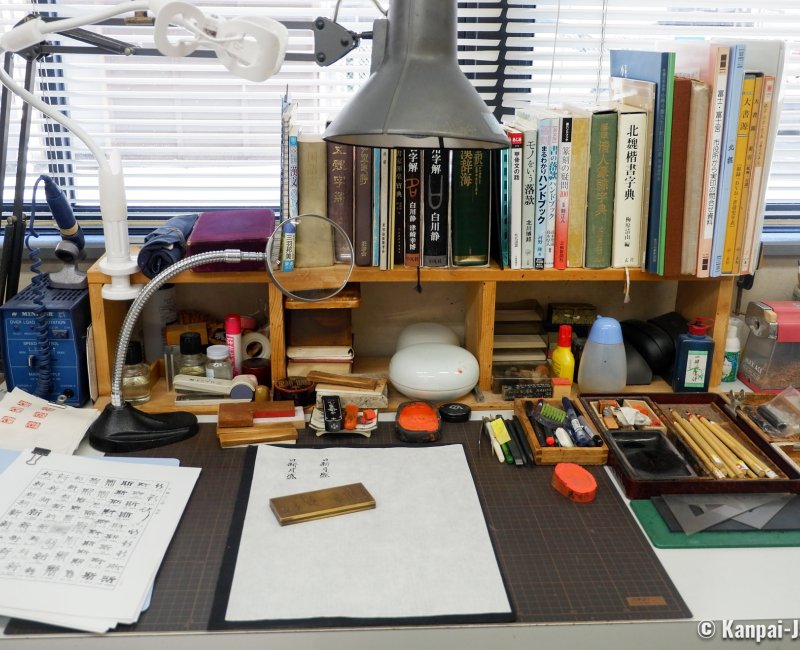Hanno Ozawa Hanko
Customized Stamps Workshop in Fuji
Hanno Ozawa is located in Fuji City, at the foot of the sacred Mount Fuji-san in Shizuoka prefecture. The shop sells various hanko, the Japanese name stamps used to sign all official documents. There, a professional seal maker transcribes the customers’ names into the appropriate kanji characters to create their personal inkan seal.
In Japan, the use of paper is still a thing especially when dealing with the administration, and every procedure requires a lot of document signing. And regarding official matters, you can’t just sign your name like in most countries: the Japanese must sign with an official seal called inkan (印鑑). For this purpose, they always carry around a small stamp called hanko (判子) and the necessary ink. The hanko is customized to the name of its owner, only in kanji, the traditional Japanese ideograms.
A necessity for any adult living in Japan, the hanko stamp is also required for foreigners who would like to settle in the archipelago for a few months or longer.

Hanko name stamp: A Japanese institution for the every day life
There are two common types of Japanese name stamps:
- The mitome-in (認め印) stamp for every day use, cheap and easily purchasable. These ordinary hanko can be bought from the shops making them, usually at the counter and they are carved with the most widespread Japanese surnames. People just have to choose the one they need. It is also possible to have one made in about 10 minutes following a fixed pattern by an automatic engraving machine. This kind of stamp is used for the most simple actions: when receiving a registered letter or parcel or to prove that a document has been read for example.
- The jitsu-in (実印) seal is used for official actions. It is unique and registered at the town hall which provides a certificate defining the type of seal and stating the identity of its owner. This certificate is required to have the stamp made and to use it afterward, when signing important documents such as a work contract or when buying a house. Sometimes, opening a bank account and conducting financial transactions may require another seal, called ginko-in (銀行印) that is registered at the bank.
In practice, not all the banks or estate agents strictly request the use of an official seal. Foreigners are sometimes allowed to use hand-written signing or just an ordinary stamp, not necessarily officially authenticated.
Regardless, both types of hanko can be purchased at the same hankoya (はんこや) shop. Foreigners who have a seal designed to their name usually use the katakana syllabary, one of the Japanese writing systems specifically used for foreign words. In Fuji City’s Hanno Ozawa shop, it is possible to have a seal designed with kanji characters.

A boutique - workshop at the foot of Mount Fuji
Located on a street corner away from the city center, Hanno Ozawa shop is divided into two parts. At the ground floor, the shop displays various kinds of hanko, some being made of beautiful natural materials like wood or stone. The associated accessories such as carry cases and ink pads are also available to purchase.
The owner settled the stamps workshop at the upper floor, in a large and warm room with a view on Mount Fuji 🗻. A table at the center of the room is allocated for designing and making seals. The owner’s kindness and know-how are strong features of the stone hanko making workshop.

The wonderful experience of choosing one’s own Japanese seal
The first step is to choose a Japanese ideogram to transcribe one’s name into a seal. There are more than 6,000 characters available, each with one, two, three or more pronunciations. One has to find the sound closest to one’s own name or to its first syllable, so as to make clear that the kanji refers to the seal’s holder.
Besides phonetics, it is also important that the kanji’s meaning or main underlying idea reflects one’s own personality. That is where the artisan at Hanno Ozawa’s comes into play by helping the workshops’ participants finding the appropriate character(s).
The next step is to choose the kanji design. As a matter of fact, ideograms styles have changed over centuries, with more or less round shapes for example. Here again the artisan gives some advice to help deciding on a style.
The stamp-making starts by drawing the selected kanji on a paper and practice carving on a test-hanko. The artisan shows how to draw the ideogram correctly. Once this step is completed, you’ll start carving the seal you’ll bring back home. The workshop takes a little bit of time, in a studious and friendly atmosphere, resonating with the soft sound of the tools engraving the stone.
The seal making is accessible to every one (except maybe to children), even to people with no drawing skill. It is a very rewarding manual activity, that gives the satisfaction to have carved one’s own inkan seal. Very few places have this kind of authentic workshop, with the additional perk of being helped by an ideogram expert. The experience is strongly recommended to anyone liking Japanese script.

